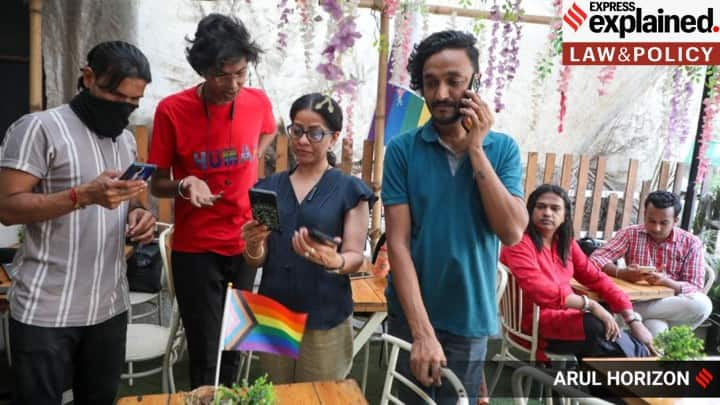
Revisiting American Queer Legal History
Lessons from Baehr v. Lewin (1993) and United States v. Windsor (2013) that bolster the demand for judicial intervention in the ongoing marriage equality case in India
The debates in India regarding the legality of queer marriage have been ongoing for several years. The petitioners, most of whom are same-sex couples and queer individuals, argue that marriage for queer couples is a fundamental right that cannot be denied. However, the government of India is firmly opposed to such unions, claiming that the appropriate forum to debate the issue of marriage is the Parliament, not the Court. Additionally, The Solicitor General of India argued that it was never the legislative intent of any of India’s marriage laws to solemnize the union of same-sex people or other queer individuals. Even as the debate has narrowed down to the Special Marriage Act, of 1954, (SMA) the government maintains its stance that the legislative intent of the SMA was to solemnize the union solely between “a biological man and a biological woman” and that the state has a “legitimate interest” in limiting such unions to heterosexual and cisgender people only.
As the issue continues to be debated in the Supreme Court of India, it is worth examining a landmark US Supreme Court case from 2013 (United States v. Windsor) and a lesser-known case from the Supreme Court of the State of Hawaii in 1993 (Baehr v. Lewin) that dealt with almost identical issues as is being faced by queer Indians today. Senior Advocate Mukul Rohatgi, representing the petitioners, highlighted Windsor on the first day of the hearings and correctly pointed out that the case provided a useful framework for understanding the issues at stake before the Supreme Court of India today. In the Baehr v. Lewin case, the Supreme Court of the State of Hawaii made the first attempt to legalize same-sex marriage in the USA, before the legislature.
Legislative Bans on Same-Sex Marriage in the United States and the Defense of Marriage Act (DOMA)
In the United States, legislative bans on same-sex marriages first gained national attention in the early 1990s after the Hawaii Supreme Court heard arguments for the legal recognition of same-sex marriage in Baehr v. Lewin – this was at a time when homosexuality was still considered a criminal offense under the then-existing “sodomy laws”. In 1993, the Hawaii Supreme Court ruled that same-sex marriage bans violated the equal protection clause of the Hawaii state constitution and argued that the state needed to offer a compelling reason for denying these couples marriage licenses. In 1996, the Circuit Court upheld the Hawaii Supreme Court’s decision, but conservative religious groups made an effort to alter public opinion, and, in 1998, 69 percent of voters approved a ballot initiative to amend Hawaii’s constitution to allow the state legislature to restrict marriage to heterosexual couples only.
It was in the midst of these events that the federal government under President Bill Clinton passed the Defense of Marriage Act (DOMA) in 1996. For the purposes of federal law, this Act specifically defined marriage as the union between one man and one woman only and also granted individual states the authority to not recognize same-sex marriages that were performed and recognized in other states. DOMA also specifically stated that “the word ‘spouse’ would refer only to persons of the opposite sex who are a husband or a wife. The implications of this law were that it denied many benefits and recognition to same-sex couples that heterosexual couples enjoyed. These benefits included, but were not limited to, over 1,000 federal protections and privileges such as access to a spouse’s employment benefits, the recognition of the marriage itself, the rights of inheritance, joint tax returns and exemptions, and the right to cohabit together in college or military housing.
United States v. Windsor (2013): A Landmark Civil Rights Case
In 2007, two women, Edith Windsor and Thea Spyer were married in Canada. They later returned to their home state of New York, which recognized their union. However, Spyer passed away in 2009, leaving her estate to Windsor. When Windsor sought to claim the federal estate tax exemption for surviving spouses, she discovered that section 3 of DOMA barred her claim. As highlighted before, this section defined “marriage” and “spouse” to exclude same-sex partners for federal law purposes. Despite paying $363,053 in taxes, Windsor sought a refund, which was denied by the Internal Revenue Service. In response, Windsor filed a lawsuit, challenging the constitutionality of DOMA.
In February 2011, President Obama and Attorney General Eric Holder concluded that Section 3 of DOMA was unconstitutional and inappropriate to defend. Thereafter, the Bipartisan Legal Advisory Group (BLAG) of the United States House of Representatives decided to intervene on behalf of the leadership in the U.S. House of Representatives to defend DOMA. In June 2012, Judge Barbara Jones of the District Court ruled that Section 3 of DOMA was unconstitutional because it violated Windsor’s rights under the Equal Protection Clause of the Fourteenth Amendment. The court ordered that Windsor should receive the tax refund she had sought. The Second Circuit later affirmed this decision.
The issue eventually reached the US Supreme Court, and in a 5-4 judgment, the top court affirmed the lower court’s ruling and held that Section 3 of DOMA was indeed unconstitutional. In its judgment, the majority acknowledged that when Windsor and Spyer first sought to marry, neither New York nor any other state in the US granted them that right, which is why, in 2007, they had to travel abroad to Canada to wed. Eventually, New York and 11 other states, including the District of Columbia, liberalized their marriage laws to include same-sex couples. However, in the backdrop of this loomed DOMA.
The majority held that DOMA sought to injure the very class of people that the State of New York sought to protect and by doing so, the Act violated the ‘liberty interest’ under the due process clause of the Fifth Amendment of the US Constitution. This liberty included the state’s obligation to provide equal protection under the law to all persons, including same-sex couples. This ruling eventually paved the way for the full recognition of same-sex marriage at the federal level and marked a significant milestone in the fight for LGBTQ+ equality and civil rights in America.
Baehr v. Lewin (1993) and United States v. Windsor (2013): Relevance to India
The landmark judgment in Windsor provides a useful framework for understanding the constitutional issues at stake in the debate over marriage equality in India. The US Supreme Court recognized that for the state to deny same-sex couples the legal recognition of marriage was an infringement of their constitutionally guaranteed right to liberty and equal protection under the law. This is particularly relevant in the current scenario where the ruling government has consistently stated that it views marriage only as a legal union between a “biological man and a biological woman” – a definition identical to DOMA.
In fact, a July 1996 United States House Judiciary report justified the need for enacting DOMA by arguing that it was necessary to combat the “orchestrated legal assault being waged against traditional heterosexual marriage by gay rights groups and their lawyers.” Moreover, just as Navtej Singh Johar v. Union of India (2018) laid the groundwork for starting the legal challenge to recognize queer marriage in India (The Navtej verdict reads in part: “The LGBT community possesses the same human, fundamental, and constitutional rights as other citizens do since these rights inhere in individuals as natural and human rights”), so too did the Hawaii Supreme Court judgment in Baehr v. Lewin pave the way for gay rights advocates to fight for marriage equality in the United States. It should be noted that for the first time in US jurisprudential history, Baehr v. Lewin recognized that the denial of marriage licenses to same-sex couples constituted discrimination on the basis of ‘sex’ and that sex was a “suspect category” under the Equal Protection Clause of the Hawaii Constitution, and hence, any restrictive marriage statute could be upheld only if the state of Hawaii could pass the strict scrutiny test.. The government of India’s response to the petitioners is almost identical to that of the United States House Judiciary Committee report, which categorized Baehr v. Lewin as a “legal assault against traditional heterosexual marriage laws”. It appears as though history is repeating itself.
The only caveat to remember here is that Windsor held Section 3 of DOMA unconstitutional insofar as it interfered with the laws of other US states that already recognized same-sex marriage. It did not confer a constitutional right for same-sex couples to marry nationwide. Thus, legislative action preceded Windsor. However, the clock was set in motion in Baehr v. Lewin which did not have any legislative precedent. Thus, it is incorrect for the government of India to argue that issues of marriage must necessarily be debated in Parliament first. This position ignores the role of the Supreme Court of India as the final arbiter of constitutional rights.
Just like the Hawaii Supreme Court, the Supreme Court of India need not wait for Parliament or any state government to pass a DOMA-type law before adjudicating on the constitutionality of marriage equality. Navtej and National Legal Services Authority v. Union of India (2014) already held that sexual orientation and gender identity are protected classes along the category of ‘sex’, and in a string of landmark cases in the Supreme Court of India, like Lata Singh vs State Of U.P (2006) and Shafin Jahan vs Asokan K.M (2018), the court has uniformly held that in a “free and democratic country, and once a person becomes a major he or she can marry whosoever he/she likes.” (in Lata Singh and re-iterated in Shaffin Jahan).
Conclusion: The Basis for Judicial Intervention
Thus, the government’s opposition to queer marriage is not a valid reason to deny queer people their constitutional rights. The Constitution of India guarantees equal protection under the law to all citizens and also directs the government to protect the rights of all citizens, regardless of sexual orientation or gender identity. The Supreme Court of India should thus take a proactive role in protecting the rights of queer couples to ensure that the ethos and spirit of the Constitution are upheld.



